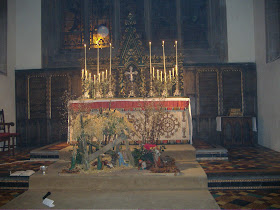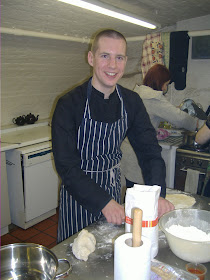Any hardcore trad flicking idly through liturgical manuals or vestment catalogues from the unassailably ‘Trad’ decades of the 40s and 50s may be perturbed to see emerging from the yellow, dusty pages of their Burns and Oates library the roots of a conflict where there is much wailing, and gnashing of teeth. The issue is the very same one that concerns us today; namely, Roman/Latin chasuble versus Gothic. The continuing strength of feeling manifested by both camps in this interminable war for aesthetic predominance in Catholic worship is evinced by such things as the Facebook ‘Society for the Promulgation of the Latin Chasuble’ where fans of the fiddle back share images of their favourite vestments and add derisive comments to photos of anything else. Add to this the insistence of some Catholics on promoting the poncho as a liturgical vestment under the title of “the fuller shaped chasuble of the early Church” and we have the roots of a bitter and protracted War of the Vestments.
Back to the dusty yellow books, a pile of which is slowly growing on my desk at work. While looking toward post-War Catholic literature for vestment patterns and other sound advice, I came across a book called
The Making of Church Vestments by Graham Jenkins, published in 1957 by Challoner, London. Mid-way through the chapter on chasubles, the author is compelled to make “a digression” in which he fulminates against the Latin cut and dismisses the Victorian Gothic vestment as inauthentic, selections of which are worth quoting here:
“When vestments were specified and codified, art began to influence the style and decoration of vestments …Once the early conservatism and deliberate simplicity had gone, the artists freely expressed themselves in the decoration of vestments…Of the vestments the chasuble was the most affected … With the arrival of elaborate decoration, heavy materials, gold wire and jewels, the chasuble became heavy and stiff, with a growing inconvenience to the wearer. Thus the sides were hacked away more and more as time went on; probably the baroque period reduced the chasuble to its smallest dimensions and in slightly later times the splendour of real baroque deteriorated to tawdry and commercial imitations. (Fig. 12)”
The picture at Fig. 12, which I am unable to reproduce here, shows a pear-shaped chasuble laden with raised gold-work embroidery and applied pieces of metal-work, including an image of Our Lady in a glory. I think it looks quite nice.“…In This country, mainly through Pugin and the Gothic revival, there arose a move to be rid of the very small vestment, and a creation arose which has since been called the “Gothic chasuble”. This was not very large, but the vestment was at least carried over the shoulder and some way down the arm. Mostly the back and front were identical, falling to a point at the base... Since this period, the square vestment has been called “Roman” and the pointed variety “Gothic”. It is misleading terminology, and has led to confusion.”
On this last point, the author is quite right. Both terms disguise a multitude of varieties. Not all chasubles that are square at the bottom are called Roman, as indeed the Spanish cut ends in this shape, despite being heavily cut away behind the shoulder-blades. Nor is everything floppy to be called “Gothic”, as Jenkins goes on to explain:
“As the liturgical movement prospered in this century, a move began to restore the fuller shaped chasuble of the early Church…Thus in our own time there are three main distinctions which for want of better names must be described as “Roman” (square), “Gothic” (pointed), and the full vestment.
The author ends his evaluation of the different types with the assertion that:
“There is no point in perpetuating Victorian or nineteenth century continental vestments in the twentieth century. The present trend is towards simplicity with good shape and sober decoration.”
This last passage is probably the only frightening thing in an otherwise harmless book, for the author’s obvious distaste for the artistic heritage of Catholic Christendom, and his promotion of the paired-down and simplified “full chasuble” on account of its supposed antiquity of design foreshadows much of the iconoclastic behaviour that occurred in churches along with the liturgical reforms of Vatican II.
It is this “full chasuble” which is promoted by liturgical modernists to this day. Made of cheap, synthetic fabrics and decorated with any possible number of designs (see the aforementioned Facebook group for some truly hideous examples), this type of vestment is now the standard in most Roman Catholic churches in the UK, and has been carried over to Anglo-Catholic parishes that use the modern Roman rite. Its cheapness means that many identical chasubles can be bought relatively cheaply for Concelebrated Masses, clergy in choir-dress having practically disappeared for the sake of including everybody in the actions of the liturgy.
I do wonder what on earth could have justified the insertion of this thesis on the chasuble into a small book which otherwise contains practical advice on how to make vestments: perhaps the very same factors that caused J.B. O’Connell to put his foot down in the 1956 edition of
The Celebration of Mass. In the chapter on Sacred Vestments, he notes the interest of the Sacred Congregation of Rites in the revival of Gothic vestments by some dioceses in Western Europe, quoting:
“…the Congregation of Sacred Rites thinks that the reasons which led to the change in question may be of some weight, having referred the matter to our most holy Lord, Pope Pius IX, it has been decided cordially to invite your lordship, in so far as these changes may have taken place in your diocese, to explain the reasons which led to them.” P.235
At that time, the only form of chasuble allowed was that in use in the Roman Church, the square-shaped Latin vestment. For O’Connell, the subject of vestment shape is not one of mere taste or preference, but rather of canonical obedience:
“According to the legislation of at present in force, then, for Churches of the Latin Rite, in the making and use of vestments, it is not lawful, without consulting the Holy See, to depart from the present received usage of the Church of Rome, and introduce another style and shape, even an old one.” P.235
The other style and shape to which O’Connell is referring here is explained in a footnote on p. 234, and is identified as “that which would be called now the medium-sized medieval chasuble”, in other words the “full chasuble” previously discussed.
Again, it strikes the reader as highly unusual that an issue such as this would concern O’Connell so much as to dedicate two whole pages and copious footnotes to this issue, especially in a chapter that is otherwise light on vestment history, and even ignores the question of whether or not a Deacon’s dalmatic and a Subdeacon’s tunicle are, or should be, materially the same vestment. The proper shape of the chasuble in the Latin rite was clearly a subject of some controversy well before the 1960s, and it seems that the rebelliousness of certain English diocesans chimed well with the “out with the old, in with the new” ethos of liturgical reform. Ironically the same obstinate attitude in the same places is preventing a full roll-out of the ‘reform of the reform’ under the current Pontiff.
Back to the present time then, and the competition between various vestment shapes is still on. While the full horror of the poncho-chasuble appears to have abated, and the trend is now, as we know, towards a resurgence of “traditional” aesthetics in the celebration of both novus ordo and usus antiquior rites, fault-lines are already emerging and they appear to be geographical. In the UK, it seems that both Anglican and Roman Catholics have taken on the “Roman” style of vestment as the most appropriate shape for traditional liturgy. The ‘English Use’ aesthetic in Anglo-Catholicism has long been diluted and absorbed into the mainstream of Anglican liturgical life, although in London at least it remains strong in centres such as All Saints’ Margaret Street and St. Cyprian’s, Clarence Gate. For Roman Catholics, the Gothic shape has, perhaps, suffered from its similarity to the limp, synthetic vestment of yesteryear and the generation of young, conservative Catholics that is driving the new liturgical movement in this country tends to prefer Latin over Gothic.
However, the trend in the States appears to be quite different. Gothic High Mass sets feature prominently on the new internet markets for parishes taking up the Extraordinary Rite. In the land of EWTN, the candy-land Gothic aesthetic dominates, as evinced by the recent refurbishment of Seton Hall Chapel (photos available here). The same principle extends to the re-discovery of literature aimed at explaining and teaching the Tridentine Mass. A British reprint of Rev. William O’Brien’s 1933 book,
In Sacristy and Sanctuary, features original illustrations of a priest vesting in a highly-decorated alb and Latin chasuble. In an American reprint of the booklet
How to Serve Low Mass and Benediction by the same author, the same illustrations have been copied and adapted by a new artist and the fully-vested priest is now shown wearing a pointed Gothic chasuble and Roman biretta.
A year on from the issue of the Motu Proprio Summorum Pontificum, it is still far too early to tell whether the trend towards traditional liturgy will affect the Catholic mainstream. It’s my own opinion that the Tridentine Mass will not take off (unfortunately) in every Roman Catholic Parish, and will probably never re-establish itself as the main Sunday service. On the other hand, the rediscovery of what was abandoned after Vatican II will affect the look of Novus Ordo masses everywhere, as the Catholics attempt to recover the dignity and order embodied in the
usus antiquior. Expect to see quality vestments of both Latin and Gothic forms to be part of this.
Elsewhere, Anglican Catholics in the Forward in Faith grouping are by necessity sharing in each other’s Sacramental lives, and this closeness and cooperation has stirred the waters of our liturgical life. I know that my church, we are constantly being kept on our toes, as some spikey parish down the road resurrects such practices as the silent canon, last Gospel or even deacon's "broad stole"! The ultramontanism of some parishes in Forward in Faith and the self-consciously loyal “Englishness” of others means that for as long as there are Catholics, both vestment shapes will have their partisans. The reader of dusty old copies of Fortescue, Muller and Kuenzel, (or hopefully, one day, modern reprints of these books) need only know to which side he belongs.






 Chancel, with some beautiful monuments
Chancel, with some beautiful monuments
 Blessed Sacrament chapel with MU banner
Blessed Sacrament chapel with MU banner




 A donkey looks on, choking on an artificial pine-needle. When there was no room at the inn, someone suggested the bandstand at the end of the road.
A donkey looks on, choking on an artificial pine-needle. When there was no room at the inn, someone suggested the bandstand at the end of the road. Coloured lights in the Kylie Kristmas Krib
Coloured lights in the Kylie Kristmas Krib














